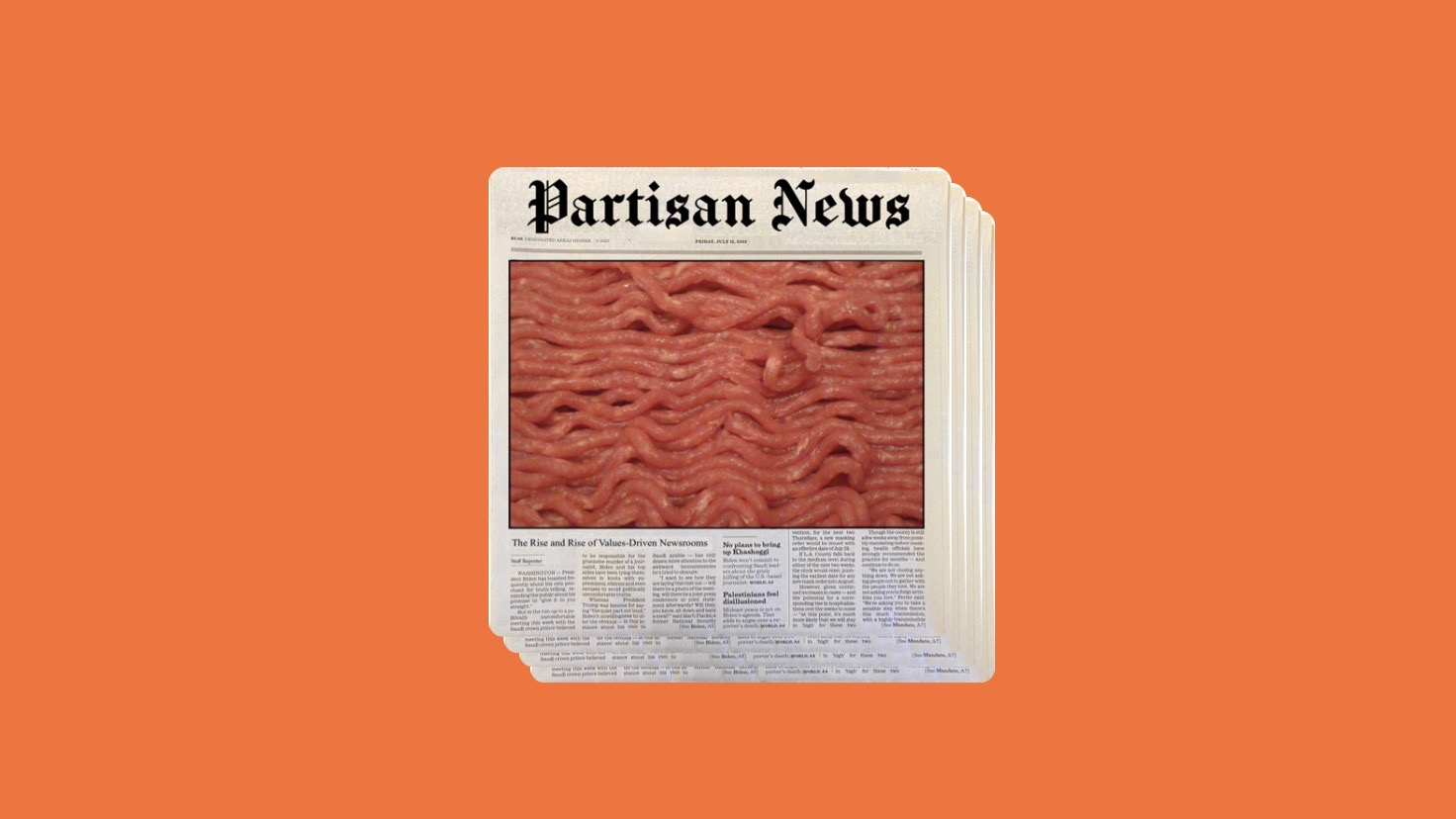Sign up for The Media Today, CJR’s daily newsletter.
When the doors of the Texas Senate Chamber opened for the 2019 session, there were two new faces at the press table.
Both were employees of Texas Scorecard, then the reporting arm of the influential Tea Party–aligned group Empower Texans, with press credentials from the Senate. Empower Texans had donated millions to elect right-wing Republicans. Now, despite opposition from some lawmakers who saw them as lobbyists, the group said it would hold them to account on the floor, too.
It is part of a deeper shift in US media, where more than two thousand local newspapers have vanished since 2004. Some of the vacuum has been filled by partisan, digital-first journalism like Texas Scorecard.
“The advocacy and the journalism can intermingle,” said Matthew Watkins, managing editor of news and politics at the Texas Tribune, a nonprofit newsroom founded in 2009. But done badly, it can hurt legitimate journalism. “It’s muddying up the water where it causes people to trust everything a bit less,” he said, referring to the right-wing Texas Scorecard.
Tow has conducted an audience study on partisan news that can be viewed here.
There are two broad categories of politically motivated outlets in the US: First, what’s become known as “pink slime” journalism. These are networks of local newspapers that deploy algorithmic stories and display a lack of funding transparency as well as a casual attitude to reporting conventions such as bylines or mastheads. They have trumpeted conservative talking points across all fifty states.
Second, partisan newsrooms. The question of their value is much more complex: Some produce original reporting, some less so. These sites typically do have connections to their localities and produce solid journalism, but their news coverage tends to be steered by politics—they sometimes receive funding from candidates or political action committees (pacs).
The danger is that readers—who often encounter these newsrooms on the flattening interfaces of social media—are being served up emotive, partisan, divisive news disguised as community reporting, conflating the two.
‘Pink Slime’
Bad journalism habits have earned these networks the nickname “pink slime,” after the meat by-product substance sometimes added to beef.
Over the past three years, the Tow Center has researched the emergence and tactics of pink-slime journalism, focusing on the sprawling Metric Media network of roughly twelve hundred sites. Tow’s investigations have outlined how sites that present themselves as local news are used to bolster conservative talking points, serving as political platforms for aligned interest groups and as crisis management tools. The argument sometimes made by Brian Timpone, one of the main people behind Metric Media, is that local news is dying, so some reporting is better than none.
“They are filling the void of local coverage in a very sinister way—they’re not getting the full story, they use misleading headlines, they insert opinions and biased stories,” said Alex Mahadevan, director of MediaWise at the Poynter Institute. “They’re filling this information vacuum with garbage.”
The names of outlets are “very deliberately chosen so that when an article circulates on social media, the source looks legitimate,” said Penny Abernathy, a visiting professor of journalism at Northwestern University. “What it does is contribute to the polarization down at the state and local level, which in the US have not historically voted along party lines.”
The consequences for democracy are potentially stark. Jennifer Kavanagh, a senior fellow at the Carnegie Endowment for International Peace and the author of the 2018 report “Truth Decay,” warned if people can no longer agree on the facts at the local level, the infrastructure of local governance is open to abuse—causing malpractice and corruption.
The problem is accelerating. A Tow Center investigation found that during the pandemic at least a hundred more news organizations shuttered, at a time when good information was more vital than ever.
Partisan Newsrooms
Partisan newsrooms are more complex. They often publish well-researched articles by on-the-ground journalists, but their reporting is driven by politics, and it can sometimes be hard to decipher opinion from news.
This type of newsroom is not limited to one end of the political spectrum, with Texas Scorecard linked to Republicans and Courier Newsroom connected to Democrats.
But more mainstream news outlets now also proudly mix political activism with journalism. For Laura Quinn, founder and president of political consulting firm Catalist, who has been an unpaid adviser to Courier Newsroom, it is more important to measure the quality of reporting and level of transparency within these newsrooms: Do they have editors and reporters in the places they cover? Do they follow journalistic guidelines and ethics? Do they go beyond algorithms and press releases?
“Equating or even comparing the two distinctly different types of digital enterprises fails to recognize quality—and further incentivizes a race to the bottom,” Quinn said.
This is a debate that gets to the heart of whether journalism can ever be values-free. “The older I get, the more I begin to disbelieve the whole concept of journalistic objectivity,” said Mark Jacob, the former metro editor at the Chicago Tribune and now a freelance writer who has done consultancy work for Courier. “The very act of assigning a news story to a reporter is a value judgment.
“I’m not saying Courier should be someone’s only media diet,” Jacob said. “It’s certainly not a replacement for a legacy local news outfit.” But “places like Courier can do good journalism if they lead with their values, they serve their audiences but do it with facts.”
Yet concerns have been raised about the wider implications for US democracy if partisan-driven reporting continues to grow. “I believe journalism should speak truth to power” on both sides of the divide, said Ryan Zickgraf, a freelance journalist and whistleblower of Journatic in 2012, a now-defunct company that was run by the same people as Metric Media. (Zickgraf coined the term “pink slime” back in 2012.)
“What I worry about over the long term is it’s part of this growing ecosystem of Republican and Democrat newsrooms, even Republican and Democrat companies, and what we think of as nonpartisan will be a relic of the past,” he added.
Part of the Political Furniture
After Texas Scorecard was granted Senate press access in 2019, Watkins of the Texas Tribune did not notice much change in its output. The group continued to focus coverage on right-wing talking points—immigration, tax cuts, “critical race theory,” and favorable coverage of Trump-endorsed candidates—but its blurring of opinion and news sparked an ethics debate in the state. The outlet even filed a First Amendment lawsuit to challenge a decision by the Texas House to bar press access, but it was later dismissed in federal court because the legislative session was over.
Texas Scorecard, which in 2020 was spun off as a separate nonprofit entity from Empower Texans, did not respond to multiple interview requests.
As the election cycle gets underway in earnest and the midterms approach in November, instances like that in Texas are likely to become increasingly common. Partisan newsrooms are likely to play a role not simply as recorders of events—straight-edged coverage of community affairs—but as actors on the stage, pushing agendas and backing candidates.
“Just in the same way as TV ads or rallies, it’s something we need to be covering and thinking about and informing readers about in our regular election coverage,” Watkins said.
For pink-slime outlets, the strategy is to trade off the trust and legitimacy of local news—which still holds weight—while attacking political opponents and boosting preferred candidates. In this way, partisan newsrooms are both a symptom of and an accelerator of politicization.
Here is a guide to what we know about the major players running networks of partisan US news sites.
SOME OF THE BIG PLAYERS
Metric Media
The network of roughly twelve hundred sites, founded in March 2019, is the country’s largest, with a presence in every state and a greater number of titles than Gannett. It says on its website that it publishes “over 5 million news articles every month.”
Brian Timpone, an entrepreneur with a history in automated news at Journatic, which was found to deploy fake bylines by This American Life, built the network. (“I’m a biased guy. I’m a Republican,” Timpone once told the Washington Post.) Bradley Cameron, a Texas brand management consultant, is the chief executive.
Metric Media’s hundreds of sites produce largely automated daily articles: press releases on the weather, sports, business data, and local government agendas. But a smaller number of non-automated articles push favored right-wing Republican candidates and smear Democrat or “rino” rivals—across multiple outlets simultaneously.
A Tow Center investigation in 2021 discovered the network has financial ties to founders of the Tea Party movement; to the nonprofit DonorsTrust, which Mother Jones describes as “the dark-money ATM of the conservative movement”; and to CatholicVote, a political advocacy group that ran a $9.7 million swing-state campaign against Joe Biden in 2020.
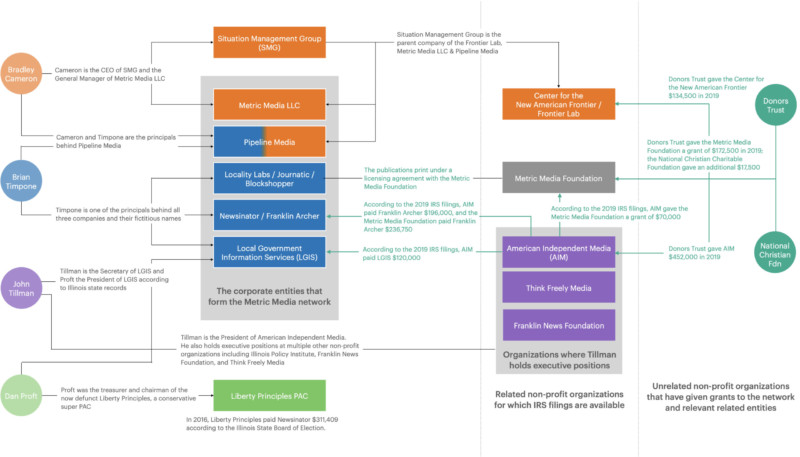
A Tow Center investigation in 2021 discovered the network has financial ties to founders of the Tea Party movement; the nonprofit DonorsTrust, which Mother Jones describes as “the dark-money ATM of the conservative movement”; and CatholicVote, a political advocacy group that ran a $9.7 million swing-state campaign against Biden in 2020.
A New York Times investigation also revealed the network engages in “pay for play” coverage, in which Republican groups and PR firms ordered favorable news coverage from freelance writers that runs on Metric Media sites. The network, the Times concluded, is built “not on traditional journalism but on propaganda.”
Since Tow’s last investigation, in 2021, Metric Media has featured favorable coverage of Donald Trump–endorsed candidates including Kari Lake, running for Arizona governor, who has shared a platform with QAnon and far-right figures.
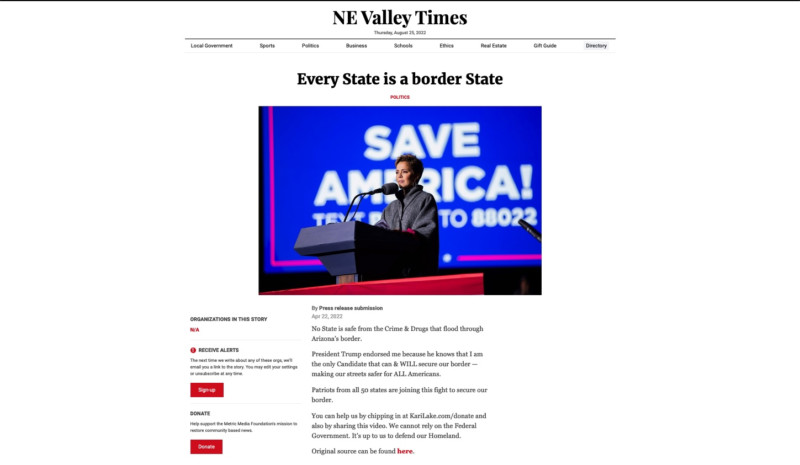
Metric Media sites have linked to Kari Lake’s donations page.
Metric Media and Brian Timpone did not respond to comment or interview requests.
American Catholic Tribune Media Network
The American Catholic Tribune Media Network was founded in March 2020. A Tow Center investigation, using third-party tools including RiskIQ and Farsight DNSDB, revealed Catholic Tribune sites shared digital markers with Metric Media sites—including Google Analytics IDs, unique analytics tokens, server IP addresses, and shared design templates.
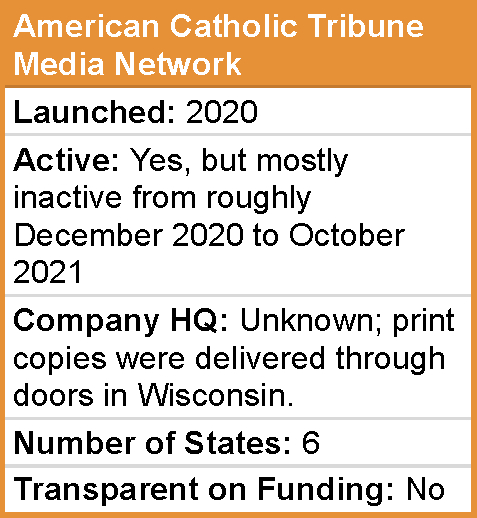 It’s composed of six sites in swing states (Arizona, Florida, Michigan, Wisconsin, Pennsylvania, and Wisconsin) alongside the nationwide American Catholic Tribune. It says it does not “endorse a particular political candidate or party.”
It’s composed of six sites in swing states (Arizona, Florida, Michigan, Wisconsin, Pennsylvania, and Wisconsin) alongside the nationwide American Catholic Tribune. It says it does not “endorse a particular political candidate or party.”
In addition, the Catholic Tribune network is owned by Franklin Archer, a company that received over $200,000 from the Metric Media Foundation for “publishing” services, according to 2019 IRS 990 filings.
The Catholic Tribune news sites followed a digital-first strategy in 2020, spending $31,314 in total on 160 Facebook ads. (The sites also became a venue for digital ads bought by the nonprofit CatholicVote, according to a Tow Center analysis of Google’s advertising platform.)
The Catholic Tribune sites appear to follow the wider theme of pink-slime journalism conducting political campaigning by other means. The outlets are not tied to any diocese, and focus on political coverage instead of community news.
Moreover, the Catholic Tribune network courted controversy in 2020, when it was accused of taking copyrighted content from The Compass, the Catholic newspaper for a Wisconsin diocese, for its Wisconsin edition. (The Compass said it stopped the practice after being notified.)
The sites also branched out into physical publishing in October 2020, with the Wisconsin Catholic Tribune delivered through letterboxes ahead of the election.
The American Catholic Tribune Media Network did not respond to multiple interview requests.
Star News Digital Media network
Star News Digital Media, launched in 2017 and dubbed a network of “baby Breitbarts” by Politico, is a collection of eleven sites across swing states with titles such as the Tennessee Star, Minnesota Sun, and Ohio Star.
The network was founded by three Tea Party–connected activists. Michael Patrick Leahy, the chief executive and editor in chief, is also a Breitbart writer. Steve Gill, cofounder and the Tennessee Star’s former political editor, has led right-wing protests against income tax. And Christina Botteri, the Star’s chief technology officer and executive editor, was a founding member of the National Tea Party.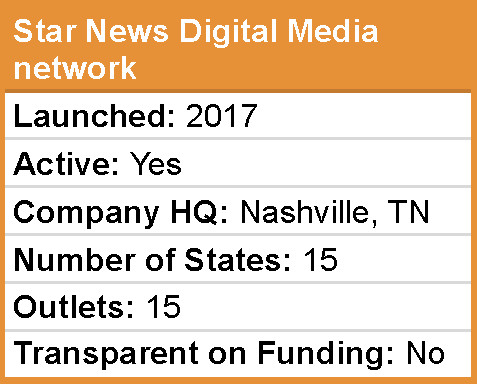
The Star network maintains close connections with Steve Bannon, former executive chairman of right-wing Breitbart News. It embedded Bannon’s War Room podcast on each Star News homepage. In 2018, Leahy told Politico the “Breitbart of Tennessee” would be a fair description of the Tennessee Star.
Star webpages have attracted millions of clicks. Articles on the network’s sites have been amplified by political candidates and even used in campaign advertisements, such as those of Diane Black, former Republican House representative for Tennessee.
The network does have real connections to the places it reports on, such as Tennessee, where the editor in chief is based. The network’s titles also report on other states, including Arizona, Minnesota, Ohio, Georgia, and Virginia.
But Star News sites have been criticized by journalism ethics professors for appearing nonpartisan while pushing divisive right-wing agendas, articles lacking bylines, and murky financial information. More recently, sites have pushed false rumors about “ballot stuffing” (and other theories popular with people seeking to delegitimize Biden’s 2020 victory over Trump).
The sites even appear in other media outlets. Politico found that The Hill and the Tennessee Journal both mentioned the Tennessee Star without underscoring its political bias.
An investigation by Snopes revealed a media consulting company owned by Steve Gill has received payment from a Republican candidate, Joe Carr, who later received favorable Tennessee Star coverage. This has driven fears partisan sites could be used to skirt electoral spending regulations.
Star News Digital Media did not agree to multiple Tow Center interview requests, but told Snopes that payments from Republican candidate Carr to Star cofounder Gill’s consulting firm were “unrelated to the Tennessee Star.”
Courier Newsroom, owned by Good Information
Courier Newsroom, now owned by Good Information, oversees about twenty journalists working across eight online publications in different states.
The organization is led by Tara McGowan, a former Democratic strategist who ran the super-pac Priorities USA. She joined from Acronym, which ran a roughly $100 million digital campaign against Trump in 2020 and formerly owned Courier Newsroom. (After it launched, Good Information acquired Courier from Acronym.)
Courier titles include The Gander in Michigan, UpNorthNews in Wisconsin, and Dogwood in Virginia.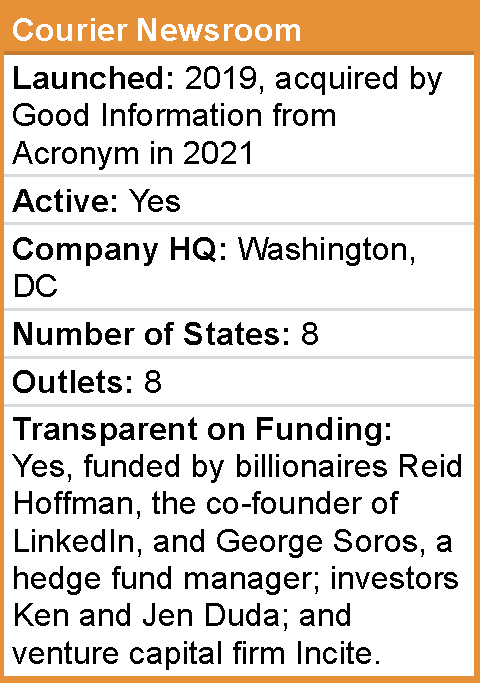
Since it launched, there have been persistent questions about the company’s links to Democratic activists and concerns Courier is trading off the legitimacy of local news to push partisan causes. But a spokesperson told the Tow Center he rejected the notion that Courier’s mission is political campaigning by other means.
Good Information was founded in 2021 to “fund and scale businesses that cut through echo chambers with fact-based information,” including investing in local news reporting.
From an initial investment of $65 million, Vox reported, funding came from billionaires Reid Hoffman, the cofounder of LinkedIn, and George Soros, a hedge fund manager; investors Ken and Jen Duda; and venture capital firm Incite.
But concerns were raised that the output of Courier’s titles (when owned by Acronym) was essentially Democratic propaganda. Reporting by Politico found the company was blurring the lines between campaign advocacy and a newsroom, such as its 2020 coverage of Democratic representative Max Rose featuring what was essentially a rewrite of his press release.
A 2019 strategy document from McGowan, first reported by Vice, outlined her vision for Acronym: “Content designed to drive strategic narratives to key audiences will be delivered on a drip over time, reaching voters through targeted ads and boosted across” social media. The goal, it adds, is to “persuade and mobilize voters online.”
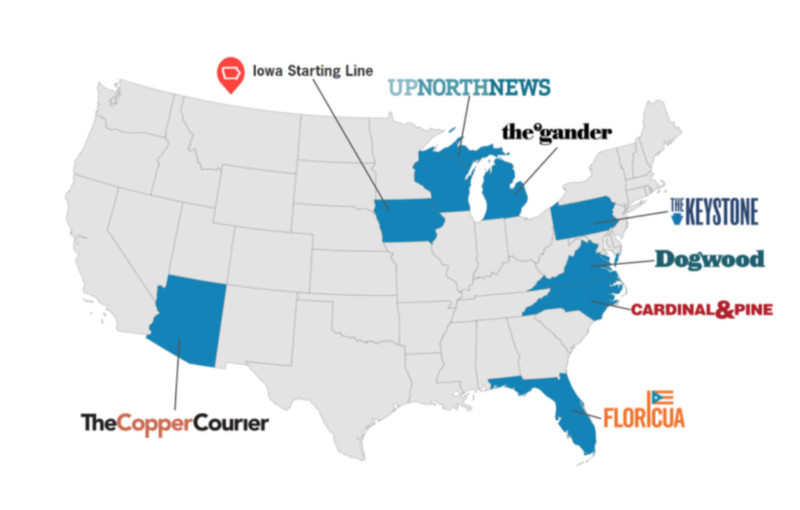
Courier Newsroom’s titles. Graphic: Courier Newsroom
But since McGowan launched Good Information and left Acronym her messaging has changed, with the company promising to tackle misinformation and rebuild trust in democracy, rather than helping Democrats fight Republicans in an information war. “The information crisis we’re in is so much bigger than politics,” she told Axios.
A Good Information spokesperson told the Tow Center that Courier is a legitimate network of newsrooms—saying that Courier is investing in real on-the-ground reporting; that it discloses its funders and values transparency; and that the newsrooms follow industry guidelines on fact-checking, corrections, bylines, and the separation between reporting and opinion.
Quinn, the political consultant who has advised Courier in an unpaid capacity, said that although Courier is values-driven, it follows rigorous journalistic standards—unlike some other outlets with a political bent. “Their newsrooms are staffed by actual journalists with local knowledge and presence, and they are upfront with their audiences about their values,” she said. “That sets them apart from enterprises that are operated far afield from the communities they claim to cover and rely on artificial-intelligence machinery to compile and generate their content.”
The company has responded to criticism about its partisanship and now discloses the values that drive its reporting—journalists must be based in the state they are reporting on—but questions remain over whether the outfit will produce quality journalism or propaganda ahead of the midterms.
The Center Square
The Center Square was founded in 2019 and is a project of the nonprofit Franklin News Foundation, headquartered in Chicago. (CJR reported in 2013 that the forerunner to Franklin News Network, the Franklin Center for Government and Public Integrity, was a leading media investment of the Koch brothers.) Center Square previously operated as Watchdog.org.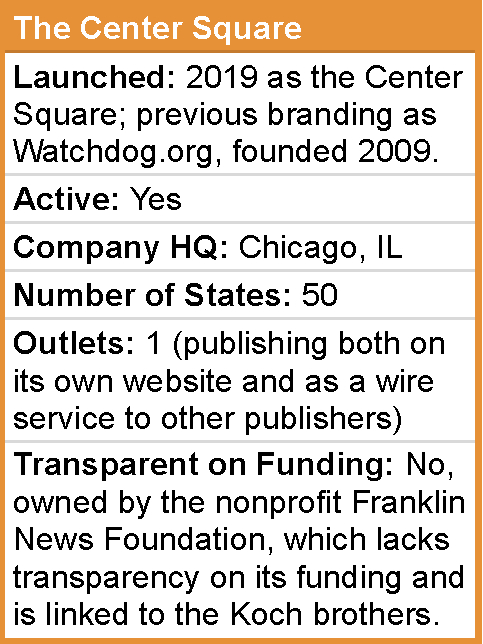
Reporting on all fifty states, the outlet skews conservative. It says its mission is to do local reporting informed by “a taxpayer sensibility,” helping readers become better informed about “state and local government and its cost to the citizens whose tax dollars fund governmental decisions.” Recurring coverage issues include immigration, education, energy, and veterans’ experiences.
The publisher, Chris Krug, is a former publisher of the Chicago Pioneer Press newspaper chain and deputy editor of the Denver Post.
Joshua Benton, the cofounder of the Nieman Journalism Lab, wrote in 2011, when Center Square was still operating as Watchdog.org, that partisan newsrooms are not necessarily bad as long as they are producing new reporting.
“Viewed as replacements [of local newspapers], they fall short of what we’d expect from a good newspaper. But as supplements, I’m happy that both exist—that in a state with both a [left- and right-leaning] site, both sides of the aisle will be poked and prodded, and that stories will surface that otherwise wouldn’t,” he wrote. “I’d draw a distinction between ideological outlets as drivers of political culture—Fox News being a prime example—and as drivers of new information.”
But despite the publication’s reporting, concerns have been raised about dark money in local news used to push a free-market perspective.
The Center Square is structured through a series of regional editors and a team of twelve permanent staff reporters. According to its online masthead, there are twenty-nine editorial staffers. The newsroom did not reply to an interview request.
Has America ever needed a media defender more than now? Help us by joining CJR today.




